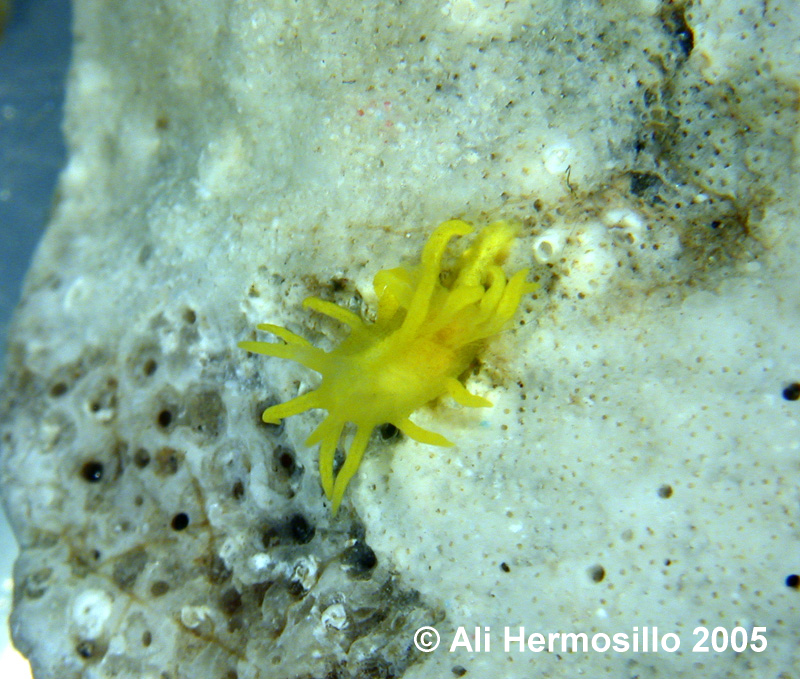 |
Okenia cochimi
Photo courtesy of Ali HermosilloIslas Revillagigedos, Mexico
Okenia cochimi Gosliner & Bertsch, 2004
Terrence Gosliner and I named 3 new species of Okenia Menke, 1830, from the Mexican Pacific and Gulf of California coasts (Proc. Calif. Acad. Sci., vol. 55, no. 22, pp. 414-430; 30 September 2004). Two of these species have already appeared as Nudibranchs of the Week: Okenia angelica (01/10/05) (BOW 448) and Okenia mexicorum (BOW 464). Sufficient specimens of O. angelica were observed at Bahía de los Ángeles, Baja California, that we were able to summarize annual and monthly occurrences. Eighteen specimens of O. mexicorum were collected from Bahía de Banderas, Jalisco, and Ensenada de los Muertos, Baja California Sur.
This nudibranch of the week features the rarest of the species we named in this paper, Okenia cochimi. It was described based on 3 specimens: two from Isla Espíritu Santo, Baja California Sur, and and one specimen from Isla Cedros, Baja California. Recently, Ali Hermosillo has recorded the species from Islas Revillagigedos (see opening photograph).
When the Europeans first landed on and then traversed the Baja California peninsula by foot and mule, they found there were 3 major groups of indigenous peoples: the Pericú, the Cochimí, and the Paipai/Kumiai, respectively in the southern, central and northern portions of the peninsula. Only descendants of the Paipai/Kumiai survive, in northeastern Baja California and southern California (the Luiseňo group present in San Diego county). The Cochimí lived in the area where the great cave paintings and murals have been found, in the Sierras de San Francisco, Guadalupe, San Juan, and San Borja. From the very first encounters with the Cochimí, legends related they were not the painters nor direct descendants of them. (See the book by Harry Crosby, “The Cave Paintings of Baja California,” (1984), and its revised edition.
Some years ago, Terrence Gosliner and I named a species of chromodorid, Mexichromis amalguae (BOW 183) based on the original Cochimí name for Isla Cedros, amalgua, which means “isle of fogs.” This distinct species of Okenia is also named in honor of this now-extinct indigenous people of the Baja California peninsula.
The living animals are small, 2-4 mm in length. The body is moderately elongate and relatively high. There is a well-developed, distinct notal border. The foot extends posteriorly and is devoid of papillae. The body color is uniformly lemon yellow. There are 5-8 pairs of elongate lateral papillae. The two anterior-most papillae are situated in front of the rhinophores and are directed anteriorly. A single medial papilla is present mid-dorsally anterior to the gill. The gill consists of four unipinnate branches. The rhinophores are elongate with 5-6 congested lamellae. The genital aperture is situated on the right side of the body approximately a third of the length of the body posterior to the head. The foot is narrow and is wider anteriorly. The oral region is rounded and lacks distinct tentacles.
Internal anatomy is clearly described in our paper.
No other species of Okenia has a uniformly colored yellow body.
References
Gosliner, Terrence M., & Hans W. Bertsch. 2004. Systematics of Okenia from the Pacific Coast of North America (Nudibranchia: Goniodorididae) with Descriptions of Three New Species. Proceedings of the California Academy of Sciences 55 (22): 414-430.
Rudman , W. B. 2004. Further species of the opisthobranch genus Okenia (Nudibranchia: Goniodorididae) from the Indo-West Pacific. Zootaxa 695: 1-70.
Imperial Beach, Calif
May 2005